Mat with an elephant and a horse. TWIX Method
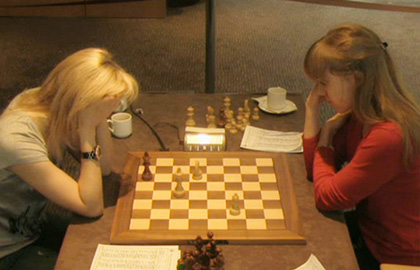
Ushenina (pictured left, plays white) - Kettlebell (pictured right, plays black). Draw.
Women's Grand Prix, 4th round
May 6, 2013, Geneva
In 2013, the Russian grandmaster Olga Girya in a hopeless position, instead of giving up, used non-standard cheating .
Having two figures less, she found a witty way to achieve a draw with the world champion (at that time) Anna Ushenina. Olga simply exchanged everything that was possible and reduced the game to the endgame “king + elephant + horse VS king”. The Ukrainian chess player, fifty moves unsuccessfully tried to mate the enemy king, after which the result of the game was declared a draw.
Offensive draw significantly influenced Ushenina’s result in the tournament. She took 5-6th place, and a win would allow to divide bronze (3-5th place).
However, we will not be too strict for Anna. In a chess environment, it is generally accepted that a mat with an elephant and a knight can not be studied. The absolute majority of chess players never in their life have such a balance of power. In serious practice, known cases of this endgame can be counted on the fingers of one hand. In 1979, at the 47th championship of the USSR, Yuri Balashov successfully completed this quest (thanks to which he was on the same line as Kasparov in the standings). The bike is also known when the Kiev master Eusei Polyak did not manage to put this mat and when asked why he didn’t drive the king to the right angle, he aphoristically answered: “I drove him, but for some reason he didn’t go there.”
How often this situation occurs in the blitz - no statistics. But probably more often than in serious tournaments.
Grandmaster Grischuk (black) demonstrates excellent knowledge of the TWIX method and checkmates with an elephant and a horse to Grandmaster Karjakin (white)
Is it worth it for a chess player to study the mat with an elephant and a horse or not? I think it’s worth it and for the following reasons:
- If a player participates in tournaments, then he will not look stupid if this situation still arises.
- If a player likes to play blitz, then even having reached a material advantage in a couple of pieces, an unpleasant surprise can await him. A seasoned rival may well exchange "all that is superfluous" and "run away for a draw" following the example of Olga Geary.
- Studying this endgame helps to understand the non-trivial principles of cooperation between an elephant and a horse . These two figures are so different that they are considered poorly interacting with each other. The legendary Tal was very fond of “the rook VS elephant + horse” and won a lot of spectacular games with such a balance of forces (Mikhail Nekhemievich preferred the rook at the same time). Formally, a boat has less material weight than two light pieces, but it often dominates them, since the horse and elephant seem to often exist in different dimensions.
- Learning to put this checkmate is much easier than it might seem. Many do not even try to study this ending, because they mistakenly believe that for this you need to play at least at the level of a candidate for master of sports. But in fact, a third-rate player will master.
- Putting a mat with an elephant and a horse, especially in time trouble - brings great pleasure. I know what I'm talking about.
If you intend to learn how to checkmate with an elephant and a horse, then let's do it.
Tips to the naked kings
In the case of this ending, the weakest side has an excellent chance of a draw. You can justifiably rely on:
- Pat. This is the main danger when the opponent is already driven into the right angle and a mat is about to be expected. One wrong move and ...
- The rule of 50 moves. With the best game on both sides, the checkmate is placed somewhere in 30 moves, however, you can’t expect an ideal game. This is especially true when pushing the king to the edge and to the corner. This is not easy, the king breaks into the center of the board at the first opportunity. If 5 dozen moves went on an aimless pursuit throughout the territory, then after this limit the weakest side has the right to a draw.

- I’ll lose one of the figures. Quite unexpectedly, a situation may arise when a lone king attacks both light pieces at once and one of them is inevitably lost. An elephant can protect a horse or a horse can protect an elephant - but at the same time, these figures cannot protect each other at the same time.
- 3x repetition of a position. The lone king should return to the place where he was before this at the earliest opportunity. It is possible that the owner of light figures will have to return to their previous positions so as not to let the king go to the center. If this "back and forth" repeated 3 times in a row - a draw in your pocket.
- The delay of time is the strongest side. Since this is a kind of deep endgame, it is possible that everything happens in the last seconds. At the same time, the strongest side has to think a lot more, because you need to build the correct design. If the owner of a female elephant calf collapses a flag on his watch, defeat, of course, will not be counted (although if the opponent does not have a naked king, but there is at least a pawn, they will count), but they won’t see victory either.
- The opponent’s inability to checkmate with a horse and an elephant. Perhaps the main hope that allows you to get dry out of the water. Because 99% of chess players have no idea how to win in this position (although you can learn in an hour).
The mat is placed in the corner of the same color as the elephant. Therefore, the naked king in no case can not strive there. The maximum program is to try to be in the center.
If you can’t keep in the center, then when pushing to the edge, you should rest and not go to the corners.
If it is not possible to stay in the middle of the edge, then it is worth going to a corner opposite the color of the elephant. In this corner, the mat will turn out unless cooperative.
When the phrase “elephant color” is repeatedly mentioned in the article, it is not the color of the figure itself, but the color of the fields along which it moves. Elephants are distinguished not only as white and black, but also as white-field and dark-field.
Another piece of advice is to attack light pieces whenever possible. A horse whose radius of action is not much higher than the royal one is especially vulnerable. You should not run away from a horse and an elephant, but go towards them.
Main stages
Even if the opponent follows all of the above tips, with the right game he cannot avoid the mat. With the most stubborn resistance, the following stages of the matting process can be distinguished:
 | Stage 0Suppose the most difficult option is the cursed king in the center of the board. |
 | Stage 1First of all, you need to push the king to any edge of the board. |
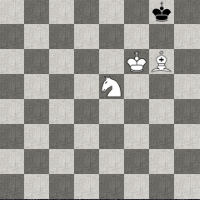 | Stage 2Push the king to one of the corners. An experienced adversary will aim at a corner opposite the color of the elephant. In this corner it is possible to checkmate only if the cursing king voluntarily helps in this. |
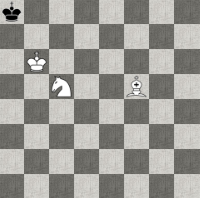 | Stage 3If the enemy is in the wrong corner, then it doesn’t matter. Knowing the TWIX method, you can easily transfer the king to an angle that matches the color of the elephant. |
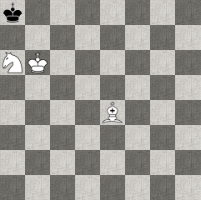 | Stage 4After the king has been transferred to the desired angle (the color of the corner must match the color of the elephant), a checkmate is put. |
Pushing
At first glance, the task of pushing from the center to the edge of the board and into the corner looks difficult, because the king, elephant and horse are not very strong and too different figures. It seems that they make up a rather weak and disorganized team and in their ranks a lone adversary will always find gaps through which he will deftly escape.
However, this impression changes dramatically if you mark the fields that a small detachment controls around the enemy king.
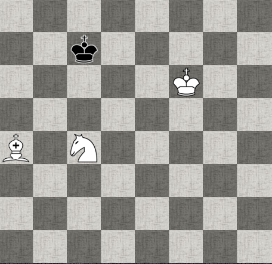
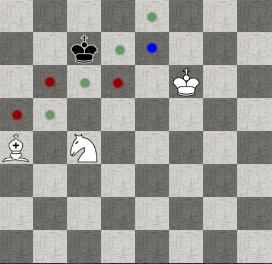
It turns out that, as a rule, an insurmountable barrier is formed for the enemy, who is forced to back away, receiving less and less room for maneuver.

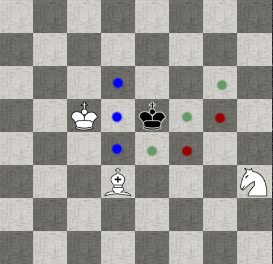
In principle, one does not need to know special secret techniques in order to drive a lone enemy king into any corner with the joint efforts of the king, elephant and horse. It is enough to just step neatly and systematically, cutting chunk after chunk of free space.
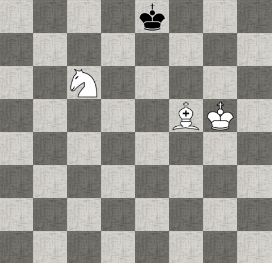
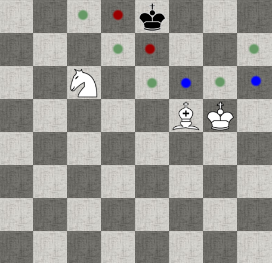
However, a few tips and nuances can be voiced:
- Come on a wide front.
- Try to keep the horse and the elephant in the fields of the same color. When a horse stands on a black field - he controls the white fields, when on a white - black. Therefore, if the elephant and the horse are in the fields of the same color, they control both the white-field and black-field sections of the board.
- Do not block the elephant with a horse or king.
- Unlike a horse and an elephant, a king can simultaneously control fields of different colors. By the way, of all three figures available, the king is the strongest.
- The king is at the forefront! It is better if the elephant and horse stand at a respectful distance from the enemy monarch (so as not to be killed by them) and from there they fire at the fields around him. And you need to attack the adversary with your leader. Kings cannot stand on neighboring cells, so boldly act as a king towards your counterpart - he will be forced to retreat.

TWIX Method
If the king is in the corner, but not that.
Generally speaking, the king can be immediately sent to the desired angle, for example, using the method of Deletan's triangles ( which is discussed in the next article ). This method is quite complicated in execution, requires accurate calculation in the tree of options and, more likely, is suitable for computer players.
And the chocolate method is for the lazy. The main thing is to drive into a corner, in which - it does not matter, if that - then it will be possible to translate according to a completely transparent algorithm.
The name of the method is due to the fact that first we build all the characters with the letter T , then the horse, zigzagging along the W- path, protected by the king (moving strictly in a straight line in the form of the letter I) and supported by an elephant (which, if not standing on the very edge, always controls two crossed diagonals in the form of X ) escorts the king to his final destination.
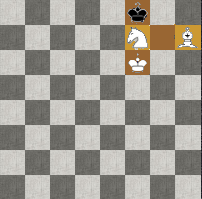
Cell
To change the angle using the TWIX method, the mated king must first be in the corner opposite the color of the elephant. Then such a construction is constructed in the form of the letter T lying on its side . It is from this position that the TWIX method begins, when the victim is carefully transferred to another corner, where he receives the mat.
To create this T-shaped position, it is necessary not only to push the naked king into a corner (opposite to the color of the elephant), but also to temporarily put him in a “cage”. The “cage” looks like this (he removed the horse so that it does not interfere with the understanding of how the “cage” is arranged):
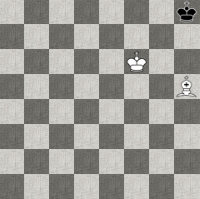
Of course, the “cage” can be in any corner of the board, no matter what color the strongest and weakest side is. This is just a private example, demonstrating the main point.
The black king cannot escape from the “cage” in any way. The motionless king of white does not allow to slip through the black fields, and the bishop controls the white fields. The black king has only 5 squares in the very corner where he can walk. If the black king tries to approach the elephant, then the elephant just goes to the other end of the white-field diagonal, and the black king remains in the “cage”.
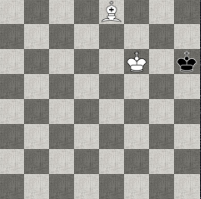
While the doomed king is awaiting his fate in the “cage,” the strongest side neatly draws the horse and calmly builds the letter T , preparing the conditions for TWIX.
Trajectories of figures
To understand the TWIX method, you need to figure out which path (and with what motives) each of the four figures on the board do.
Hereinafter, we assume that the strongest side is white, their bishop is white-field. The mated king was driven into the upper right corner (black) and must be moved to the upper left corner. Of course, this is just a particular example, but in the general case it doesn’t matter what color who is and what kind of corners we are talking about. The main thing is to realize the general principles.
The Painted King
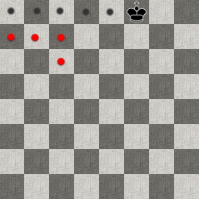
On the diagram, gray and red dots mark all the fields that the enemy can visit if the TWIX method is implemented correctly and the king fails to escape.
The doomed king is driven to the place of execution along a narrow corridor (fields with gray dots) along the very edge of the board. The weakest side may try to break back into a safe corner, but the horse controlling the black fields and the elephant controlling the white fields block his way back.
Arriving at the corner, the black king is likely to try to slip out on the other side (fields with red dots). You need to reorient the elephant in time and close the loophole (see below, “Example: An elephant does not allow the king to slip out at the final stage”).
Horse (W)
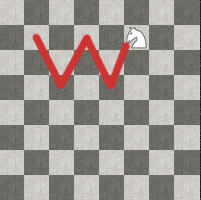
This figure is the soul of the method, it is she who drives the opponent into the matte corner. His king and elephant only help in this.
Horse carries rigidly a predetermined trajectory in the form of the letter W .
This allows you to consistently take black fields from the black king from right to left (in this case, black and from right to left, but in general the horse’s main task is to control the fields that are opposite the color of the elephant and translate from one corner to the next) and push the opponent in the right direction with the help of the cheek slider .
King of the Forces (I)

The king also has a well-defined path - to move strictly parallel to the enemy king a step away from him. This path resembles the capital vowel I lying on its side.
The main mission of the king is to support (protect) the horse, otherwise the opponent will approach the horse and eat it. Note that the king and the horse do not interfere with each other at all - the king moves only along the 6th horizontal, and the horse jumps from the 7th to the 5th and vice versa.
In addition, the king does not allow the opponent to slip from the edge, bypassing the right or left. The king of the strongest side should try to be opposite (or almost opposite) the matted king.
And the king and the horse of the strongest side should not deviate one iota from their routes, they must go exactly the path that is shown in the previous two diagrams. It happens that you have to take a step back along the same trajectory, if any of the moves are made prematurely and you need to return in order not to let the cursed king go free.
Elephant (X)
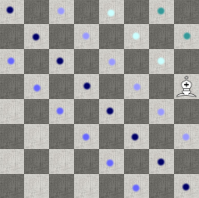
Unlike the horse and the king, the elephant does not have a strict sequence of moves. The main thing is not what fields the elephant walks in, but what diagonal it currently controls.
When the elephant is not on the edge of the board and not in a corner, it controls two the crossed diagonally, forming the letter the X .
The elephant’s task is to keep white fields at gunpoint from afar (if the elephant is white-field and needs to be converted from a black corner to white) at the edge of the board so that the king cannot return to a safe corner and, driven by the horse’s checkers, went to the scaffold.
When the opponent comes into the matte corner, he will probably try to slip out from the other side. The task of the elephant (together with the horse, which will control the fields opposite to the elephant of color) in one move to exclude this possibility.
Example: An elephant does not allow the king to slip out at the final stage
The black king is already in the matte corner, but he is trying to get out through the white field a6 . The elephant switches to the diagonala6-f1 and blocks the possibility of flight. The horse, protected by the king, does not allow to escape through the black field b6 .

The black king is already in the matte corner, but he is trying to get out through the white field a6 . The elephant switches to the diagonal
The auxiliary task of the elephant is to transfer the course to the opponent. A situation may arise when the horse and the king cannot follow their rigidly defined trajectories (if this is done, the cursed king breaks out of the environment). In this case, the elephant simply moves along the diagonal that it currently controls. The turn of the turn goes to the blacks and they are forced to move towards death again.
Example: Passing a move to an opponent.
White’s move in this position. You can’t walk as a white king - in this case the black king breaks free.
While it makes no sense to go with the knight - the opponent will go to a safe corner through the move and White will also have to return to the starting position.
However, the waiting move with an elephant along thee8-h5 diagonal allows you to transfer the turn of the move.
1. Bg6-h5 ...
Black will have to move further to the left, and White will be able to continue theW-shaped movement with the knight.
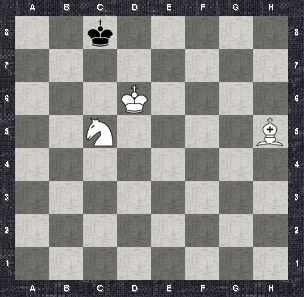
1. ... Kd8-c8
2. Kd7-c5 ...
Now Black needs to either continue to move to the matte corner (2. ... Kc8-b8) or try to return to the right safe corner, but then White completes the W-trajectory (2. ... Krs8- d8 3. Kc5-b7 + and the black king still has to go left).

White’s move in this position. You can’t walk as a white king - in this case the black king breaks free.
While it makes no sense to go with the knight - the opponent will go to a safe corner through the move and White will also have to return to the starting position.
However, the waiting move with an elephant along the
1. Bg6-h5 ...
Black will have to move further to the left, and White will be able to continue the

1. ... Kd8-c8
2. Kd7-c5 ...
Now Black needs to either continue to move to the matte corner (2. ... Kc8-b8) or try to return to the right safe corner, but then White completes the W-trajectory (2. ... Krs8- d8 3. Kc5-b7 + and the black king still has to go left).
So, once again the whole mechanism (White mates black, White has a white-field bishop).
The main spring - the horse draws the letter W on the board. This is the best way to cut off black cells from the black king and drive them to the desired angle with checkers on the edge. The white king moves strictly parallel to the edge, thus protecting the horse. The white-field bishop of White from far away controls the white fields and does not allow the black king to break through them. If necessary, the bishop also simply walks along a controlled diagonal, if you need to pass the move to black.
TWIX method example with detailed explanation of moves
This is an example where black defends as inventively as possible. Events may well develop in a slightly different sequence of moves, but here are all the cases that may arise.
 | Let's start with the position when the king is driven into a large cage. Before implementing the TWIX method, you must first prepare the conditions for the initial T- shaped position. The king is locked in a corner, but at his disposal as many as 5 fields for maneuvers. |
| 1. Bh5-g6 ... | |
|---|---|
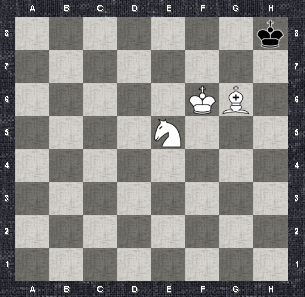 | By moving the elephant, we reduce the size of the cage to the minimum, now the king has only three fields along which he can walk. |
| 1. ... Kh8-g8 2. Ke5-f7 ... | |
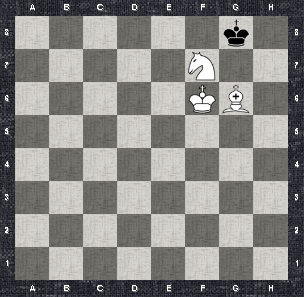 | The horse further restricted the black monarch by taking a corner. Now the matted king has only two fields. |
| 2. ... Kg8-f8 3. Cg6-h7 ... | |
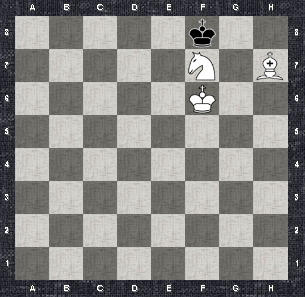 | We expel the black king from his comfort zone. The elephant blocked the ability to be near the corner. For the black king begins an unpleasant journey to the place of execution. Initial T ! It is important that in this position the turn of the move was behind the weakest side. The twix mechanism sets in motion. |
| 3. ... Kf8-e8 4. Kf7-e5 ... | |
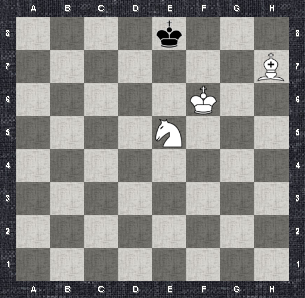 | The king is forced to take the first step towards death. The horse begins to draw a letter of the W . |
| 4. ... Kre8-d8 5. Kf6-e6 Kd8-c7 | |
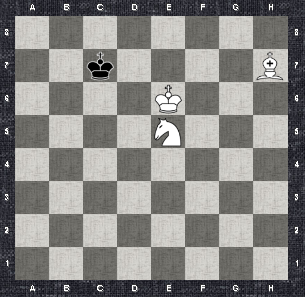 | Black does not spend time trying to return to a safe corner (by Instead, Black decided to break through in the left half of the board. The fact is that white pieces are forced to walk alternately, which slows their joint movement. The black king manages to quickly overtake them and the impression is that it is still a move - and White will lose control of the situation. |
| 5. Ke5-d7 ... | |
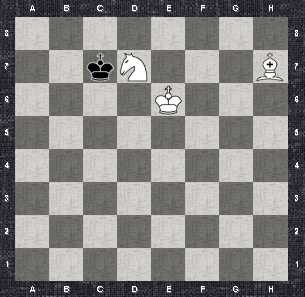 | White calmly continue to draw the letter the W . The horse has now taken control of the black fields through which the black king could seep into the center. |
| 5. ... Kpc7-b7 6. Ch7-d3 ... | |
 | The white elephant switches to the other flank, prohibiting access to the white fields and preventing the attempt to escape. |
| 6. ... Kb7-c6 7. Cd3-e2 ... | |
 | Couldn’t slip out through a6 , can it turn out through c6 ? White by the waiting course of the bishop dispels these illusions. |
| 7. ... Krs6-s7 8. Ce2-f3 ... | |
 | At 7. ... Kc6-b7 would follow 8. Kre6-d6 and the white king takes the next step along his prescribed route. Therefore, the black king has so far returned to c7 , not letting the white king on d6 . Now it’s impossible for White to walk with a king or a horse, but the bishop’s move completely blocks attempts to escape through the right flank. |
| 8. ... Kpc7-d8 9. Kpe6-d6 Kpd8-e8 | |
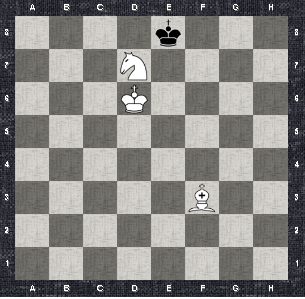 | Maybe then Black will be able to return to a safe corner? |
| 10.Cf3-h5 + ... | |
 | No, it won’t work out. The elephant is thrown back and controls the white fields. The horse controls black. |
| 10. ... Kpe8-d8 11. Kd7-c5 Kpd8-c8 | |
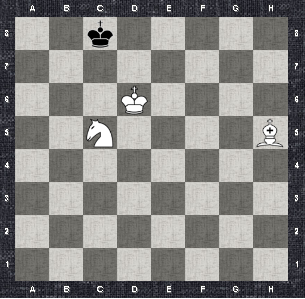 | Black has to go left, while White continues to draw W on the board . |
| 12. Ch5-g6 ... | |
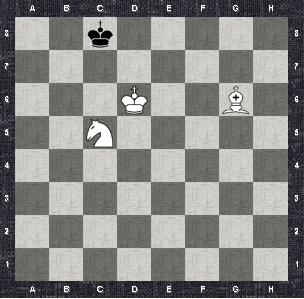 | Thin moment! Now it is premature for White to go his king, because Black will rush to a safe corner and White will also have to go back: 12. Kd6-c6 Kc8-d8. 13. Kc6-d6. Therefore, the neutral move of the bishop takes place in black. |
| 12. ... Kpc8-d8 13.Kc5- b7 + Kpd8-c8 14. Kpd6-c6 ... | |
 | Now the attempt to break into a safe corner is not terrible, thanks to it White simply drew the letter W with a check . |
| 14. ... Kpc8-b8 15. Kpc6-b6 Kpb8-c8 16. Cg6-f5 + ... | |
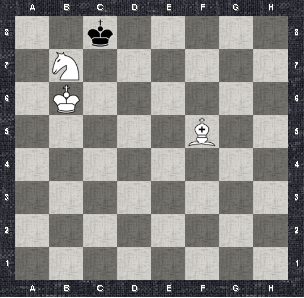 | Last attempt to jerk towards a safe corner. Just like on the 10th move, the elephant and the horse do not give the opportunity to go back. |
| 16. ... Kpc8-b8 | |
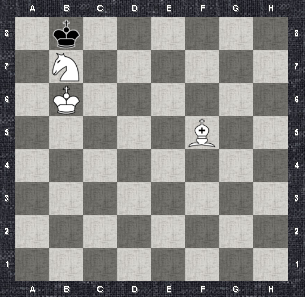 | Blacks are moved to the right corner. It remains only to checkmate. |
Mat
You can put a mat in different ways (not all options are given):
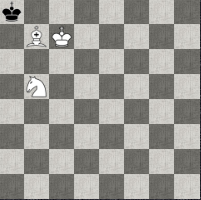

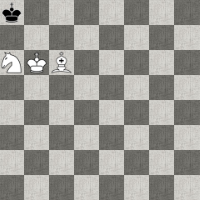
We will analyze the matte construction that organically arises from the end position of the TWIX method (third diagram). Of course, if the king was cornered not by the TWIX method, but by a different method, this mat also does not interfere with use.
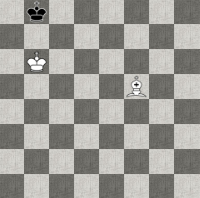
First of all, it is necessary that the mated king be in the "cage" and not be able to escape from it, while the strongest side regroups the pieces for the final mat. Like a “cage” in a safe corner, it is built by the efforts of the king and elephant (the horse has been removed from the diagram to show only the “cage”).
Only two squares are available to the black king and he cannot escape anywhere. While he is shifting from a8 to b8and vice versa, white calmly let the knight, who with the check drives the king into the very corner. Perhaps on the diagonal you will have to make a move with the bishop if you need to pass the turn of the move to black so that inadvertently there is no stalemate.
 | We continue from the position where we stopped when we disassembled the TWIX method step by step. The black king is already in the cage. It is necessary to transfer the knight to a6 (he must get there with the check) and when the black king retreats into the corner - checkmate with an elephant. |
| 17. Kb7-c5 Kpb8-a8 | |
|---|---|
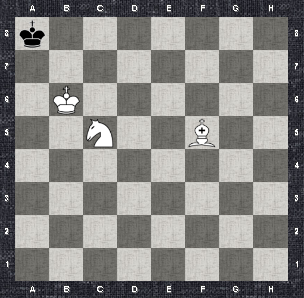 | While it is premature to go horseback, for 18. Kc5-a6 - Pat. It is necessary to pass the move to black with the move of the elephant. |
| 18. Cf5-d7 Kpa8-b8 | |
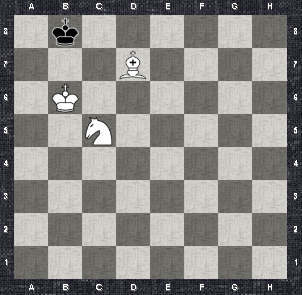 | The elephant, without taking control of its diagonal, makes a waiting move on it. The black king is now in the right field. |
| 19. Kc5-a6 + Kpb8-a8 20. Cd7-c6X | |
 | A horse with a check drives the king into a corner, mates an elephant. |
Deletan Triangles Method
The following article discusses an alternative way to push a lone king into a matte corner.

Click on the image to go to the article with the analysis of the method of triangles Deletan.
The cyclic method "Prisoner of the Caucasus"
If the enemy king at all costs tries to return to a safe corner, then there is another extremely rare way of overtaking him into a matte one.
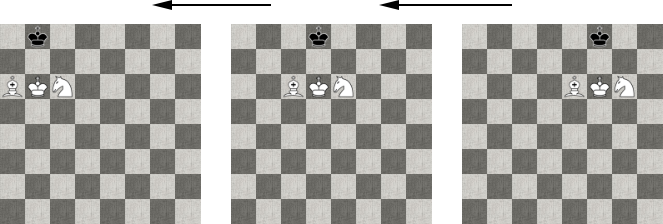
Click on the image to go to the article with the analysis of the cyclic method “Prisoner of the Caucasus”.
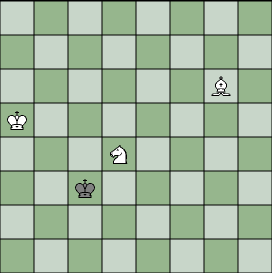
Online training
By clicking on the diagram to the right, you can practice mating with an elephant and a horse. The initial arrangement of shapes is randomly generated. The author of the simulator of the game GlukKazan , all questions, complaints, thanks, wishes and suggestions - to him :)
